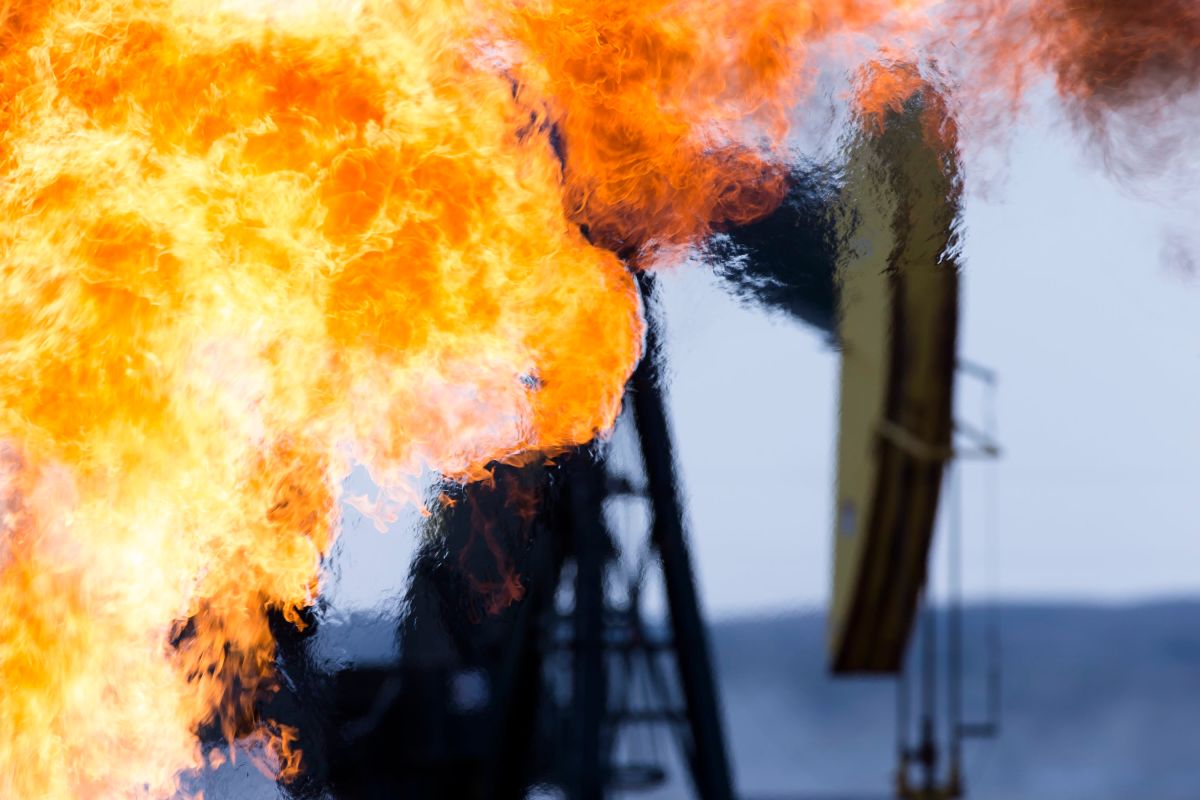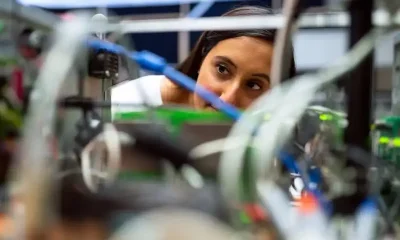Technology
The real reason why oil and gas companies are bullish on carbon capture

Two years ago, oil and gas company Occidental bought carbon capture startup Carbon Engineering. The transaction was hailed as a win-win: A climate tech company scored a significant exit, and a fossil fuel company gained a foothold in a sector that could be worth up to $150 billion by 2050.
Now we have a better idea why Occidental was keen to pick up the pricey technology: They want to use it to pump more oil.
Previously, the company had said it would use the technology to zero out its climate impact. Yet on Occidental’s earnings call this week, CEO Vicki Hollub changed the tune, saying that injecting CO2 into wells to force out more oil was imperative to boosting oil production.
“Taking CO2 out of the atmosphere is a technology that needs to work for the United States, and President Trump knows the business case for this,” Hollub said. The Verge was the first to report on the comments.
Hollub compared using CO2 in enhanced oil recovery to fracking, the technology that sent U.S. oil and gas production skyrocketing.
But direct air capture, the technique used by Carbon Engineering to draw CO2 out of the atmosphere, remains expensive at $600 to $1,000 per metric ton. The Inflation Reduction Act, though, provides some significant incentives for using captured CO2 in enhanced oil recovery, up to $130 per metric ton in 2026 if the gas remains permanently stored underground. That’s not enough to make the practice attractive on its own, but coupled with carbon credit sales, Occidental expects it can turn a profit by the end of the decade.
The Trump administration has been working to dismantle climate-related government incentives, especially the Inflation Reduction Act. But with support from companies like Occidental and ExxonMobil it’s possible that the tax credits could survive.
Carbon capture has a long and tangled history with fossil fuel companies. They first started pumping oil into dwindling wells in the 1970s, though the CO2 came from underground deposits. In the early 1980s, pipelines started stretching out from Texas, but low oil prices prevented the technique from being widely used.
About a decade ago, NRG Energy took advantage of rising oil prices to build the country’s first carbon capture facility attached to a coal-fired power plant. Called Petra Nova, the small installation was designed to capture about a third of one boiler’s carbon dioxide and use that CO2 to boost production at a flagging oilfield southwest of Houston.
It worked, though not as well as expected. Production rose from around 300 barrels per day to 6,000 barrels, a significant bump but half of what had been forecasted. NRG shut down Petra Nova in 2020 as oil prices cratered early in the pandemic and sold it to JX Nippon three years later.
Oil prices have since recovered, but enhanced oil recovery using CO2 remains unattractive in part because there isn’t enough of the gas readily available — at least, not enough to raise production by the 50 billion to 70 billion barrels that Hollub predicts the technology will unlock.
Direct air capture could easily provide enough CO2. Humans have been pumping gigatons’ worth of the gas into the air by burning fossil fuels over the last century and a half. It’s possible that carbon captured from the air could be used to make oil carbon negative, meaning the process of drilling the oil stores more carbon than burning it releases, though the concept needs to be studied further.
It’s hard to know whether federal incentives for direct air capture will survive the next four years. But of all the tax credits in the Inflation Reduction Act, they might have the best chance thanks to oil companies’ desire to continue business as usual.
Source link
rewrite this title The real reason why oil and gas companies are bullish on carbon capture
[gpt3]rewrite this content and keep HTML tags
Two years ago, oil and gas company Occidental bought carbon capture startup Carbon Engineering. The transaction was hailed as a win-win: A climate tech company scored a significant exit, and a fossil fuel company gained a foothold in a sector that could be worth up to $150 billion by 2050.
Now we have a better idea why Occidental was keen to pick up the pricey technology: They want to use it to pump more oil.
Previously, the company had said it would use the technology to zero out its climate impact. Yet on Occidental’s earnings call this week, CEO Vicki Hollub changed the tune, saying that injecting CO2 into wells to force out more oil was imperative to boosting oil production.
“Taking CO2 out of the atmosphere is a technology that needs to work for the United States, and President Trump knows the business case for this,” Hollub said. The Verge was the first to report on the comments.
Hollub compared using CO2 in enhanced oil recovery to fracking, the technology that sent U.S. oil and gas production skyrocketing.
But direct air capture, the technique used by Carbon Engineering to draw CO2 out of the atmosphere, remains expensive at $600 to $1,000 per metric ton. The Inflation Reduction Act, though, provides some significant incentives for using captured CO2 in enhanced oil recovery, up to $130 per metric ton in 2026 if the gas remains permanently stored underground. That’s not enough to make the practice attractive on its own, but coupled with carbon credit sales, Occidental expects it can turn a profit by the end of the decade.
The Trump administration has been working to dismantle climate-related government incentives, especially the Inflation Reduction Act. But with support from companies like Occidental and ExxonMobil it’s possible that the tax credits could survive.
Carbon capture has a long and tangled history with fossil fuel companies. They first started pumping oil into dwindling wells in the 1970s, though the CO2 came from underground deposits. In the early 1980s, pipelines started stretching out from Texas, but low oil prices prevented the technique from being widely used.
About a decade ago, NRG Energy took advantage of rising oil prices to build the country’s first carbon capture facility attached to a coal-fired power plant. Called Petra Nova, the small installation was designed to capture about a third of one boiler’s carbon dioxide and use that CO2 to boost production at a flagging oilfield southwest of Houston.
It worked, though not as well as expected. Production rose from around 300 barrels per day to 6,000 barrels, a significant bump but half of what had been forecasted. NRG shut down Petra Nova in 2020 as oil prices cratered early in the pandemic and sold it to JX Nippon three years later.
Oil prices have since recovered, but enhanced oil recovery using CO2 remains unattractive in part because there isn’t enough of the gas readily available — at least, not enough to raise production by the 50 billion to 70 billion barrels that Hollub predicts the technology will unlock.
Direct air capture could easily provide enough CO2. Humans have been pumping gigatons’ worth of the gas into the air by burning fossil fuels over the last century and a half. It’s possible that carbon captured from the air could be used to make oil carbon negative, meaning the process of drilling the oil stores more carbon than burning it releases, though the concept needs to be studied further.
It’s hard to know whether federal incentives for direct air capture will survive the next four years. But of all the tax credits in the Inflation Reduction Act, they might have the best chance thanks to oil companies’ desire to continue business as usual.
[/gpt
Technology
Did xAI lie about Grok 3’s benchmarks?

Debates over AI benchmarks — and how they’re reported by AI labs — are spilling out into public view.
This week, an OpenAI employee accused Elon Musk’s AI company, xAI, of publishing misleading benchmark results for its latest AI model, Grok 3. One of the co-founders of xAI, Igor Babushkin, insisted that the company was in the right.
The truth lies somewhere in between.
In a post on xAI’s blog, the company published a graph showing Grok 3’s performance on AIME 2025, a collection of challenging math questions from a recent invitational mathematics exam. Some experts have questioned AIME’s validity as an AI benchmark. Nevertheless, AIME 2025 and older versions of the test are commonly used to probe a model’s math ability.
xAI’s graph showed two variants of Grok 3, Grok 3 Reasoning Beta and Grok 3 mini Reasoning, beating OpenAI’s best-performing available model, o3-mini-high, on AIME 2025. But OpenAI employees on X were quick to point out that xAI’s graph didn’t include o3-mini-high’s AIME 2025 score at “cons@64.”
What is cons@64, you might ask? Well, it’s short for “consensus@64,” and it basically gives a model 64 tries to answer each problem in a benchmark and takes the answers generated most frequently as the final answers. As you can imagine, cons@64 tends to boost models’ benchmark scores quite a bit, and omitting it from a graph might make it appear as though one model surpasses another when in reality, that’s isn’t the case.
Grok 3 Reasoning Beta and Grok 3 mini Reasoning’s scores for AIME 2025 at “@1” — meaning the first score the models got on the benchmark — fall below o3-mini-high’s score. Grok 3 Reasoning Beta also trails ever-so-slightly behind OpenAI’s o1 model set to “medium” computing. Yet xAI is advertising Grok 3 as the “world’s smartest AI.”
Babushkin argued on X that OpenAI has published similarly misleading benchmark charts in the past — albeit charts comparing the performance of its own models. A more neutral party in the debate put together a more “accurate” graph showing nearly every model’s performance at cons@64:
Hilarious how some people see my plot as attack on OpenAI and others as attack on Grok while in reality it’s DeepSeek propaganda
(I actually believe Grok looks good there, and openAI’s TTC chicanery behind o3-mini-*high*-pass@”””1″”” deserves more scrutiny.) https://t.co/dJqlJpcJh8 pic.twitter.com/3WH8FOUfic— Teortaxes▶️ (DeepSeek 推特🐋铁粉 2023 – ∞) (@teortaxesTex) February 20, 2025
But as AI researcher Nathan Lambert pointed out in a post, perhaps the most important metric remains a mystery: the computational (and monetary) cost it took for each model to achieve its best score. That just goes to show how little most AI benchmarks communicate about models’ limitations — and their strengths.
Technology
The pain of discontinued items, and the thrill of finding them online

We’ve all been there. A favorite item is suddenly unavailable for purchase. Couldn’t the manufacturer have given you advance warning?
Whether owing to low sales, changing habits, production costs, or even because something is a little wrong with your favorite product (shh), discontinued items are part of life. In a weekend piece, the New York Times delves into the not-so-dark underbelly of online places where shoppers find these items, share tips and yes, find emotional support.
The story highlights a padded laptop bag made by Filson that a super fan now hunts “down everywhere” to snag as many as possible “before everyone figures out how great they are.” It points to Discontinued Beauty, a site whose offerings are old to visitors but new to the site. Among its latest products: an “essential protein restructurizer” by Redkin priced at an eye-popping $169.95. (The newest version of the product costs shoppers $32.)
Could it be dangerous to use these discontinued products? Who cares, suggests one creative director, who tells the Times about a lip pencil the beauty company NARS no longer sells and she has found elsewhere. “Now, do I know the proper way to store this for optimal conditions? No,” she says. “They’re under my sink.”
Technology
US AI Safety Institute could face big cuts

The National Institute of Standards and Technology could fire as many as 500 staffers, according to multiple reports — cuts that further threaten a fledgling AI safety organization.
Axios reported this week that the US AI Safety Institute (AISI) and Chips for America, both part of NIST, would be “gutted” by layoffs targeting probationary employees (who are typically in their first year or two on the job). And Bloomberg said some of those employees had already been given verbal notice of upcoming terminations.
Even before the latest layoff reports, AISI’s future was looking uncertain. The institute, which is supposed to study risks and develop standards around AI development, was created last year as part of then-President Joe Biden’s executive order on AI safety. President Donald Trump repealed that order on his first day back in office, and AISI’s director departed earlier in February.
Fortune spoke to a number of AI safety and policy organizations who all criticized the reported layoffs.
“These cuts, if confirmed, would severely impact the government’s capacity to research and address critical AI safety concerns at a time when such expertise is more vital than ever,” said Jason Green-Lowe, executive director of the Center for AI Policy.
-

 Technology8 months ago
Technology8 months agoTop 10 Technologically Advanced Countries and Their Products
-

 Technology7 months ago
Technology7 months agoWBTC (Wrapped Bitcoin)
-

 Technology8 months ago
Technology8 months agoDogecoin (DOGE) Cryptocurrency
-

 Technology9 months ago
Technology9 months agoTop 10 Trending Laptops Of 2024
-

 Technology7 months ago
Technology7 months agoEverything To Know About Litecoin As A Cryptocurrency
-

 Technology7 months ago
Technology7 months agoBKK:BCH Coin
-

 Technology8 months ago
Technology8 months agoCardano (ADA) Coin, Everything To Know
-

 Technology7 months ago
Technology7 months agoTron (TRX) Coin
